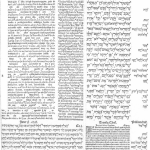RNRC PS: And Paul Donnelly writes about something I know nothing about; I print his letter here so you all can see and judge, but until I know more about the general subject I’m reluctant to shoot my mouth off about it. (“Never stopped you before!” –Hey, quiet in the peanut gallery.) It’s long enough that I’m going to put it all in plain text, rather than the usual “readers in bold, me in plain” schema. So, everything that follows in this post is from Donnelly.
[H]ere is a simple test: what’s known as the “2nd preference” in our waaay too complex immigration law. (I’ve pitched you on this before, which is why it is a test of your principles.) If you MEAN what you say (particularly 1, 2, 3 and 8), you will take this up. IMNSHO, this is the most anti-marriage, anti-family issue in American politics. But you’ll find that a subsidy for Microsoft counts for more than marriage, which is why I raise it to you (somewhat belligerently, for which I apologise) as what you might see as a matter of principle.
Otherwise, well…
Basically, the Rule (with many exceptions) for immigration policy is that each immigrant is invited. An American has to ask for them — whether a citizen petitioning for a spouse, child, parent of sibling; or a legal permanent resident petitioning for a spouse or child; or an employer for an employee. There are other categories (lottery winners), and refugees and asylees, but the Rule is: individual Americans invite individual immigrants.
But not everybody gets in right away. The spouses and kids and parents of citizens do. Everybody else has to wait (the visas are distributed through ALGEBRA, of all things) — this is NOT because the INS is inefficient (although it is), but because Congress promises more than it delivers. The MINIMUM wait for the spouses and kids of legal permanent residents is now 5-7 years. (For the siblings of U.S. citizens, it’s 10-20+.)
I told you, I wrote to Cardinal Law about this a few years ago: bupkas. The Conference of Bishops, last I checked, has said literally NOTHING about the moral distinction between siblings and spouses. By way of example, I love my five brothers and four sisters — but I live with my wife and son.
Rather than make that simple moral distinction, the Bishops (along with a coalition of self-proclaimed “pro-immigration” groups) have focused instead on MAINTAINING their coalition, which defines “pro-immigration” by preserving all existing categories — and thus, the existing management of the system by backlogs.
Which has a simple result: husbands and wives, parents and small children, are outlawed or exiled. Last anybody checked, we were talking about a MILLION people. When folks obey their marriage vows and obligations as parents, and move to live in the SAME COUNTRY as their husbands, wives and kids, they are breaking U.S. law. Immigration lawyers in particular are fond of this (see below) precisely because it gives them more business. Immigration advocates rarely think about in detail, because they are in the business of representing the poor and downtrodden — the more there ARE, the better their business.
And — folks like you? The RNRC? Let’s see.
ILW.Com
(an electronic newsletter for immigration attorneys)
The H-1B Is A Barrier To The IT Industry’s Recovery
Even Milton Friedman Says “there is no doubt” H-1B Is A Subsidy
Computerworld
July 22, 2002
H-1B Is Just Another Gov’t. Subsidy
Baltimore Sun
Baltimore’s Salvation Lies in Immigration
(w/Bruce Morrison)
June 19th, 2002
ILW.com
April 20, 2001
Time to Bury the Ratchet and Replace it with Real Reform
American Prospect
April 5, 2001
The End of Ellis Island
[This notes the failed approach which the Bishops most recently tried as “vague to the point of dishonesty”]
The New Republic
Temporary Help
One more, no longer online for free:
WASHINGTON POST
Tuesday, July 28, 1998 ; Page A15
IMMIGRATION: FAMILIES FIRST
PAUL DONNELLY
Reading Robert Suro’s otherwise thoughtful article about the effect of immigration [“The Next Wave,” Outlook, July 19] on our national distraction over race, I was struck by his distortion of the late Barbara Jordan’s views of immigration. Suro explains the Jordan Commission recommendations on prioritizing legal admissions: “[Jordan] proposed drastic cuts in the number of low-skilled legal immigrants allowed into the country in order to remedy the plight of poor Americans who might otherwise find work in urban labor markets. Implicit in the proposal put forth by the U.S. Commission on Immigration Reform, which Jordan then headed, was the notion that employers, overwhelmingly white, preferred to hire low-skilled immigrants, overwhelmingly Latino, over the native poor, especially blacks.”
In fact, most legal immigration is based on family ties, not on skills; and the core issues of immigration reform concern priorities, not numbers. With legal admissions approaching 1 million a year, the commission did propose to eliminate 10,000 unskilled employment-based visas. Continuing to import workers because of their lack of skill is certainly not Congress’s smartest move going into welfare-to-work; but American families ask for four to five times as many immigrants as employers do. And so they should.In characterizing an “implicit notion” about immigrants’ skills and employers’ racism, Suro skipped over what the commission explicitly recommended: uniting husbands and wives, moms, dads, and little kids — adding 150,000 nuclear family-based visas a year until nearly a million legal immigrants now waiting in line are here legally. These folks are overwhelmingly Mexican American (and a substantial number are also unskilled), and now face being exiled for four to 10 years or even permanently outlawed under current law.
What Jordan actually said: “We believe there are three priorities: reunification of nuclear families, admission of highly skilled workers needed to increase the competitiveness of U.S. business, and refugee admissions ….The number of immigrants should flow from these priorities.”
“For family-based immigration, the priority has to be the nuclear family. First, the spouses and minor children of U.S. citizens. Second, the parents of U.S. citizens. Third, the spouses and minor children of legal permanent residents.”
What was so unclear about these priorities that Suro and others consistently misconstrue them? Immigrants are people, not simply economic units. Ultimately, the immigration debate boils down to just three unavoidable questions: Why do we want immigrants, anyway? How many do we want? And — most important — are we willing to treat them like Americans when they get here?
Ask a congressman why we want immigrants, and you are likely to get a soaring but equivocal speech about Ellis Island, his grandparents and the melting pot. Yet the law provides a practical, not an ideal answer. Americans primarily want immigrants to unite families and fill jobs.
Ask how many we want, though, and you discover the dirty little secret of immigration policy: Congress promises far more immigration than it delivers. Nearly 1 million husbands, wives and minor children of legal permanent residents wait as much as a decade for legal admission — while the siblings of U.S. citizens face a wait measured literally in generations, (which means they enter toward the end of their most productive years).
This isn’t rocket science. There are only two ways to resolve the inexcusable, un-American separation of immigrant families: add visas or prioritize admissions. That is what the bipartisan U.S. Commission on Immigration Reform dealt with. Why? Because the answer is a lot more important than mere economics.
Are there American families, other than immigrants, where U.S. law forces husbands and wives apart and makes parents choose between jobs and their kids? Between obeying their marriage vows and U.S. law? The Jordan Commission warned Congress and the nation that we are replacing our historical approach toward immigrants — that they become us — with a policy that is pro-immigration but anti-immigrant; that flirts with a guest worker model and blurs the difference between illegal aliens and legal
immigrants while drawing a dangerously bright line between legal resident and U.S. citizen.
Suro is right on, of course, in pointing out that we need a new way to talk about race and ethnicity, to reflect what will unite us in the 21st century. But ignoring the centrality of immigrants’ nuclear families — moms, dads and little kids — and focusing instead on economic skills and prejudice in the workplace is not the way to build it.
The writer was communications director of the bipartisan U.S. Commission on Immigration Reform.











